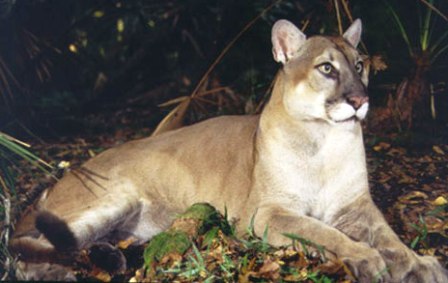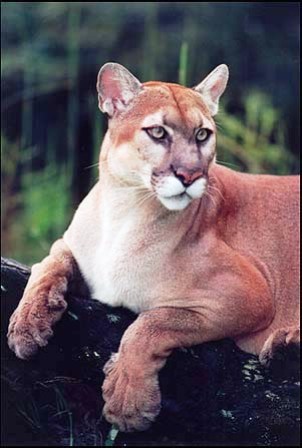Discover Florida Nature
It's time to explore the natural Florida


|
|
|
|
|
 One
of 30 cougar subspecies, the Florida panther is one of the critically
endangered species in the world. Only 80 or so Florida panthers live in
the wild today, found in the low tides, palm forests and swamps of
southern Florida. The Florida panther has been protected from legal
hunting since 1958, and in 1967 it was listed as endangered by the U.S.
Fish and Wildlife Service. The Florida panther was added to the state's
endangered species list in 1973, and it continues to be one of the most
intensively and expensively protected feline. One
of 30 cougar subspecies, the Florida panther is one of the critically
endangered species in the world. Only 80 or so Florida panthers live in
the wild today, found in the low tides, palm forests and swamps of
southern Florida. The Florida panther has been protected from legal
hunting since 1958, and in 1967 it was listed as endangered by the U.S.
Fish and Wildlife Service. The Florida panther was added to the state's
endangered species list in 1973, and it continues to be one of the most
intensively and expensively protected feline.Adult male Florida panthers weigh up to 150 pounds and can measure almost 7 feet long from the nose to the tip of the tail. Females are smaller, rarely weighing more than 100 pounds. The shape of the Florida panther's skull is characterized by a more exaggerated rise of the nasal arch, and its paws are smaller & legs slightly longer than its cougar cousin. Florida panthers have short fur that is usually tawny brown on the back and pale gray underneath, with white flecks on the head, neck and shoulder, and a whorl of hair in the middle of its back. It has a long crooked tail. It is believed that the crook and whorl are the result of recessive genes being expressed through inbreeding. Following years of persecution and habitat loss, there are about 80 Florida panthers occupying only 5 percent of their historic range. Most Florida panthers now live within a range that includes the Big Cypress National Preserve, Everglades National Park, and the Florida Panther National Wildlife Refuge. Males have a home range of 200 square miles and females about 75 square miles. The Florida' panthers' original habitat included dry areas in hardwood hammocks, pine flatwoods, saw palmetto & cabbage palm thickets, along with wet areas such as cypress forest, thicket swamps & freshwater marsh. Panthers will wade and swim canals and swamps if necessary to find drier, more secure resting places and hunt for food. Panthers prefer a secluded environment away from people and are less likely to frequent low agricultural areas and citrus groves.  Panthers
are built to hunt live prey. Deer and wild hogs are their preferred
food, but, when these are not available, panthers will eat raccoons,
armadillos and even alligators. Interestingly, panthers eating a diet of
small animals are not as healthy as those with plenty of deer to hunt.
Florida panthers can travel 15-20 miles a day, often moving in a zigzag
pattern. They can run up to 35 mph but only for a few hundred yards.
While they are good sprinters, panthers rarely chase prey for long
distances. Instead, prey is singled out, stalked and ambushed. Panthers
are built to hunt live prey. Deer and wild hogs are their preferred
food, but, when these are not available, panthers will eat raccoons,
armadillos and even alligators. Interestingly, panthers eating a diet of
small animals are not as healthy as those with plenty of deer to hunt.
Florida panthers can travel 15-20 miles a day, often moving in a zigzag
pattern. They can run up to 35 mph but only for a few hundred yards.
While they are good sprinters, panthers rarely chase prey for long
distances. Instead, prey is singled out, stalked and ambushed.Florida panthers are solitary and territorial animals and do not mate for life or live in prides but they do have a social structure. Panthers are mostly active between dusk and dawn, and rest during the heat of the day. They are usually quiet, but Florida panthers can communicate through vocalizations. Sounds they make have been described as chirps, peeps, whistles, purrs, moans, screams, growls, and hisses. Though conception can take place anytime during the year, the breeding season generally falls between October through March, and kittens are often born in the spring. The average breeding age for female panthers is 2-3 years. When the female is ready to mate she will leave special scent markings which signal the male, they will then search each other out, mate, and may stay and hunt together for a few days before going their separate ways. Panthers usually produce 1 litter every 2 years with an average litter size of 1-3 kittens. Florida panthers once enjoyed their perch atop the food chain across a vast dominion. They were all over the Florida peninsula, from the Panhandle to the Everglades. The biggest threats to the remaining panthers are their health and continuing loss of habitat. Florida panthers have an unusually large number of health problems. Most are related to poor habitat conditions and genetic defects. Around the Everglades, panthers have been contaminated with mercury by eating raccoons high in mercury, which passes through the aquatic food chain. It's sad to say that Florida panthers are killed by cars and trucks, particularly on State Road 29 and Alligator Alley (I-75), and, although it is against the law, hunters still shoot panthers occasionally. |
|
|
Advertise | Privacy Statement | Dog Encyclopedia | Video |Contact | Alaska Nature |
|